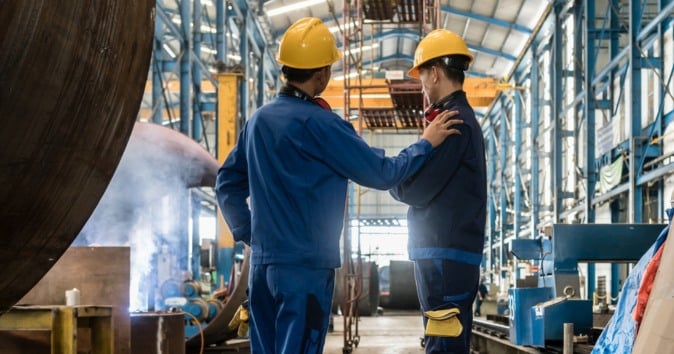Why Is Recognition Important to Employees (and Your Bottom Line)?

Why is employee recognition important?
Think back to the last time you received recognition for doing good work. How did it make you feel? Chances are more than likely you felt happy, motivated, and fulfilled.
There’s a reason for that: Science suggestsOpens in a new tabrecognition is something our brains are hardwired to need – it releases dopamine, which stimulates the parts of the brain that create positive emotions like satisfaction and enjoyment.
In the workplace, these feelings of positivity are crucial for employee engagement and overall success. Gallup and Workhuman® research shows, when employee recognition hits the mark, employees are:
- 5x as likely to feel connected to their company culture
- 4x as likely to be engaged
- And 44% more likely to be “thriving” in their life overall
But a new report from Gallup and Workhuman takes this one step further, revealing why recognizing employees is critical for cultivating an environment where both employees and the business thrive.
Let’s take a deep dive into the data to find out why recognition is important for your people – and makes good business sense, too.
Why is recognition important?
To unpack this a bit more, let’s first look at the reasons why employee recognition is important to employees.
Gallup and Workhuman’s first report, “Unleashing the Human Element at Work: Transforming Workplaces Through Recognition,” underscores the point that recognition is about who employees are as people, not just who they are as employees.
The Gallup data shows employees who have fulfilling, authentic, and personalized recognition experiences at work evaluate their lives more positively overall and are more likely to be thriving in their everyday lives.
Gallup defines strategic recognition according to the following five pillars:
Fulfilling:
Organizations should target providing a consistent and reliable experience of being appreciated to fulfill employees’ basic human need to feel valued and validated.
Authentic:
Empty words or gestures do not land well with employees – what makes employee recognition impactful is what it means to individuals, about themselves, their jobs, their teams, and their workplace.

Equitable:
Although recognizing employees should be targeted and personal, how much others receive matters – when employees see recognition that is out of balance (particularly when they feel they are being shorted), it triggers an alarm to their basic need for fairness and damages their overall employee experience.
Embedded in company culture:
Simply having an employee recognition program is not enough – a culture of recognition is one where gratitude, praise, and appreciation are freely given, regularly received, and reach all corners of the organization.
Personalized:
While getting recognition “right” can seem like a moving target, there’s a simple way to ensure a bullseye: just ask what kind of recognition (public or private) the employee prefers.
Download our exclusive report, "From Praise to Profits: The Business Case for Recognition at Work," to learn how strategic employee recognition can benefit your organization.
Here's what you'll discover in this must-read report:
1️⃣ The impact of recognition on business outcomes, including increased productivity, safer workplaces, and decreased absenteeism.
2️⃣ The cost savings recognition can yield for your organization.
3️⃣ Strategies for implementing a recognition program that is fulfilling, authentic, equitable, embedded in company culture, and personalized to the individual.
Invest in your employees and your business success by embracing strategic recognition. Download your FREE copy of our groundbreaking report now!
Why employee recognition is important to wellbeing
A big part of improving the overall lives of employees is improving their wellbeing, both inside and outside of the office. Gallup and Workhuman’s second report, “Amplifying Wellbeing at Work and Beyond Through the Power of Recognition,” shows a successful employee recognition program is one of the most effective and affordable ways to foster employee wellbeing.
Employees who feel their best, do their best – so it’s important for organizations to understand and prioritize wellbeing.
While it’s often conflated with “wellness,” wellbeing isn’t just about the absence of illness or injury, or even the presence of physical fortitude. Wellbeing is about a life well-lived – it’s about being fulfilled in the aspects of life that matter most.
The five essential elements of wellbeing
By systematically studying what allows people to thrive around the world, Gallup has uncovered the five essential elements of wellbeing:
Career wellbeing:
Refers to how people spend their days and whether or not they generally like what they do with their time (job satisfaction).
Social wellbeing:
Refers to people’s relationships with others and whether or not they have meaningful connections and are able to build positive relationships with others.

Financial wellbeing:
Refers to people’s economic stability and standard of living and whether or not they have the funds they need to provide for themselves and their family.
Physical wellbeing:
Refers to people’s health and physical condition and whether or not they have the energy and endurance to be productive each day.
Community wellbeing:
Refers to people’s daily environment and whether or not employees feel appreciated, satisfied, connected, and engaged with the areas where they live.

Employee recognition programs do more than fuel employee wellbeing – they promote a more positive outlook and mitigates burnout. Simply put, recognition is one of the most powerful ways for organizations to demonstrate their investment in and commitment to their employees and inspire them to feel connected, confident, and cared about.
The key is to understand the importance of employee recognition to your team – and to the organization – to develop a true culture of recognition.
Financial benefits when you recognize employees
Beyond the ways recognition can boost employee satisfaction, improve their lives, and support their wellbeing, it can also improve the financial success of an organization. As noted in Gallup and Workhuman’s first report, .
In fact, by making recognition an important part of company culture, a 10,000-person organization with an already engaged workforce can save up to $16.1 million annually due to reduced employee turnover.
That got us to wonder: If recognition has such an impact on reduced turnover, what other cost savings can it yield across the organization?
How recognition boosts the bottom line
This new analysis from Gallup and Workhuman, “From Praise to Profits: The Business Case for Recognition at Work” reveals exactly how a strategic investment in recognition can boost a company’s bottom line.
The report breaks down three ways recognition improves business performance through increased productivity, safer workplaces, and decreased absenteeism.
Let’s take a closer look at the research findings:
In this study, Gallup reviewed correlations between employee recognition and employee outcomes across hundreds of organizations and thousands of teams in different industries.
Globally, one in four employees in Gallup’s database strongly agree that they have received recognition or praise for doing good work in the last week.
Gallup found that if the median business in their database doubled the number of employees who strongly agree to this item, that business could see:
- 9% improvement in productivity
- 22% decrease in safety incidents
- 22% decrease in absenteeism
Using these results, Gallup calculated how much an average U.S. business of 10,000 employees could expect to save based on Bureau of Labor Statistics (BLS) data – and the results are striking.
By doubling the one in four employees who strongly agree, in Gallup’s database, to receiving or praise for doing good work in the last week, an average business could expect to save a whopping:
- $91,989,474 in gained employee productivity
- $2,807,200 saved due to decreased injuries
- $3,801,336 saved due to fewer unscheduled absences
Of course, productivity, safety, and absenteeism influence one another. For example, when employees are safe and show up for work, they are going to be more productive.
This means the dollar amounts can’t be added together to create a total savings amount. But it also means that when employees feel authentically appreciated, they drive improvements to several interrelated and compounding business outcomes.
In that sense, recognition isn’t just the right thing for organizations to do for their people – it also has a significant impact on the bottom line.
Why recognition is important in leadership

With these calculations, Gallup estimates the cost savings and improved business outcomes organizations can expect to see with increased employee recognition (technically speaking, with a doubling of weekly employee recognition in the median organization in Gallup’s database).
Yet a significant challenge remains: Only two in 10 senior leaders Gallup and Workhuman surveyed say that recognition is a major strategic priority at their organization.
Recognition remains a powerful, largely untapped way for organizations to foster employee happiness, engagement, and productivity – all while improving company performance at the same time.
Although the science validates the practical value of recognition, very few leaders are taking it seriously enough to see the benefits.
To see the true impact of recognition, businesses need to create a culture of recognition where praise and acknowledgement pervade every level of the organization.
How to improve recognition at work

Remember earlier, when we detailed the five pillars of strategic recognition? Fulfilling. Authentic. Equitable. Embedded in company culture. Personalized.
These are all of the factors companies need to take into account in order to get recognition right. It takes practice. It also requires training, tools, and resources for managers and supervisors to make recognition feel right to the people receiving it.
Here’s how you can get started building recognition at scale across your organization.
Invest in recognition as a strategic differentiator for your culture.
Culture transformation takes a unified commitment from your leadership team over the long haul. Start a conversation about the benefits of a recognition culture with your colleagues.
Review your current recognition traditions and align recognition to priorities and company values.
Have rewards become a formality? Is your recognition equitable? Do your recognition practices align with your values?
Model recognition that others can see.

Culture begins at the top. Your people are watching you to know what’s valued in your organization. Be the kind of employee you want to see more of.
Personalize recognition rather than one-size-fits-all.
It starts with the question, “How do you like to be recognized?”
Appreciate employees for who they are—not just what they do.
Employees want to feel like they can be their authentic selves at work. They want to feel known as individuals. By recognizing personal accomplishments and milestones outside of work performance, leaders can show they care about their employees as people.
The impact of recognition for employees and the business
Today’s employees feel more disengaged from their work than they have in a decade, according to Gallup research. Business is changing, and uncertainty is everywhere – and workers just want to feel like they’re valued and they belong.
The truth is this: When employees feel valued for who they are and what they do – and are treated like they’re more than a cog in the machine – they act differently, in ways that positively impact their teams and organizations.
By building a culture of recognition, leaders can see a ripple effect of positivity across the organization. It’s a win-win. For both employees and the companies they work for.
In conclusion
Let’s face it: The last few years have been tumultuous for employees and for businesses. Amidst this shifting economic landscape, it can be easy to forget that every organization is ultimately made up of people.
And what those people feel – about their leaders, their team members, themselves, and their lives – ultimately provides the fuel for high performance.
Prioritizing and building employee recognition isn’t just companies doing right by their people – it also has a massive hard and quantifiable impact across the organization.
As a business leader, you have a major, largely untapped resource at your fingertips: employee recognition. So take a moment to ask yourself:
How are you recognizing your employees for who they are as people, what they bring to the organization, and the impact they have on their teams and the business? Does gratitude in your organization feel genuine? Is praise personalized to the individual? Is the way you recognize employees perceived as fair?
The answers to these questions will help you on your path to bolstering your employees – and the overall business, too.
About the author
Stacy Thompson
Stacy Thompson is senior director of content strategy & activation at Workhuman. A lover of language, Stacy focuses on bringing company stories to life from ideation to execution. A Midwestern native, Stacy lives in Billerica, MA with her husband, two kids, and two cats – and spends her time outside of work running, skiing, writing, reading, and yoga-ing.